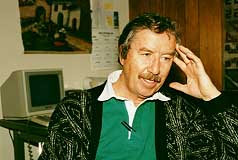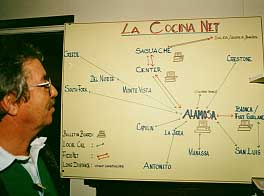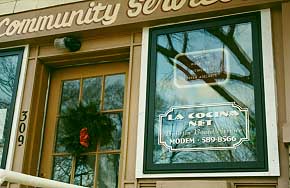A Vignette
by David R. Hughes
I have been asked by the team preparing
my nomination to tell this story.
More than a decade ago, I met Noel Dunne.
He was an Irish former Catholic priest who had worked for many years  as
a missionary among the Indians of Peru and Chile. There he learned
Spanish and helped these Indians create economic cooperatives to sell their
pottery. He then married and came to Denver, where, because of his
commitment to the poor and his mastery of Spanish, he was recruited by
the Christian Community Services to work in Alamosa, the central town of
30 very small towns, in Colorado's San Luis Valley. as
a missionary among the Indians of Peru and Chile. There he learned
Spanish and helped these Indians create economic cooperatives to sell their
pottery. He then married and came to Denver, where, because of his
commitment to the poor and his mastery of Spanish, he was recruited by
the Christian Community Services to work in Alamosa, the central town of
30 very small towns, in Colorado's San Luis Valley.
Several years earlier I had been doing
pro-bono work in the San Luis Valley from time to time, using advanced
techniques to connect up at the lowest possible cost, some very poor school
districts there to the Internet. Noel Dunne heard about that and
looked me up. He had an idea that somehow, some way, computer communications
could help support the work of CCS helping the poor in the most rural of
areas of the valley.
The San Luis Valley is 100 miles long,
50 wide, surrounded by the 14,000 foot Sangre de Cristo and Rio Grande
mountain ranges, a giant flat ancient lake bed with the head waters of
the Rio Grande River running through it en route 1,500 miles to the Gulf
of Mexico. It has been homesteaded since the 1600s by migrating Spanish,
then Spanish-Americans, then Hispanics.
This magical valley is home to some 35,000
rural folk in 30 small agricultural communities in 16 separate small school
districts. An often desperately poor, devout, people, isolated from
even the most rural Catholic churches and ordained priests, they had rich
inner lives, vivid art, an ancient religion-centered culture, beautiful
churches -- all against the backdrop of some of the most magnificent mountain
peaks in the nation. With 80% Spanish speaking and 20% Anglo in the
southern end of the valley and the reverse in the north, they were a cultural,
political, economic, educational, and technological challenge.
Earlier I had successfully linked some
schools to the Internet through Adams State College servers. And
at one of the poorest schools in central Colorado I had hooked up the first
wireless devices (using some modems never built for what I used them for)
between a classroom and a server in the building. (Somehow, this
had caught the attention of Tom Kalil, Vice President Gore's technical
advisor, who then told the FCC they needed to talk to me).
So Noel Dunne asked me to work with him
to create computer bulletin-board technology that these valley people --
immigrant families, white farmer-exploited migrant workers, the simply
poor -- could use to communicate with each other. I helped him create
a dial-up modem, local network called "La Cocina" -- the Kitchen, where
in Hispanic  homes
the important conversations take place. La Cocina's bulletin board
informed these people about housing, the education of their children, and
legal representation. It went on to provide (Noel Dunne's own specialty)
self help for very small businesses and income producing activities, and
the web based marketing of some of their products, like weaving.
Cooperative marketing allowed them to get better prices for their handicrafts. homes
the important conversations take place. La Cocina's bulletin board
informed these people about housing, the education of their children, and
legal representation. It went on to provide (Noel Dunne's own specialty)
self help for very small businesses and income producing activities, and
the web based marketing of some of their products, like weaving.
Cooperative marketing allowed them to get better prices for their handicrafts.
I then got Noel Dunne together with an
interesting woman dedicated to online education, Carmen Gonzales, and another
incredible man -- a Professor Tomas Atencio then at New Mexico University
who had a brilliant thesis called "Resolana." Resolana was
the ancient Hispanic "way of knowing" in which the men of the tiny towns
towns sat on the sunny side of the plaza and, through oral dialogue, formed
and perpetuated the values, knowledge, and wisdom of the village (unlike
the European/North American "way of knowing" through academic study, science,
and printing). Professor Atencio believed that unless traditional
Hispanics, such as those in Northern New Mexico, learned the new technologies
and used modern communications to replicate this way of knowing, they would
simply become the information-sweatshop workers of the 21st Century and
lose their ancient culture while gaining the middle class -- a prospect
that bothers Hispanics profoundly.
So, when Professor Atencio saw that I had
created an all-purpose computer language with which people could communicate
both linguistically and artistically (so that symbols could be sent back
and forth, but that's another story), he said this was the technology he
had been looking for for years. We formed a movement called "Resolana
Electronica." It flourished for a few years until the rise of the
Norte Americana World Wide Web brought the crass values of American TV
and print magazines to the Internet, and lured the Hispanic children away
from their gentle but profound "la familia" and resolana-centered community
roots.
Ironically it had been at Center, Colorado,
many years before, where the Anglo-Hispanic split was extreme, that as
Chief of Staff of Fort Carson I had for General Rogers, authorized an outreach
of civic action that gave the Hispanics who lived "south of the ditch"
in town their first septic systems and clean water pipes. We required
the  white-dominated
town government to come to consensus with the Hispanics on projects to
be done through public meetings, or we would not aid the town. In
1985 I was told by a grateful Hispanic liquor store owner, who had been
a lieutenant at Carson back then, that this had permanently changed the
political power structure in Center. Hispanics got on the school
board, into town and country politics and government, and things balanced
out better after we, the Army, left. (I had utterly forgotten that
episode. It was only after my coming to town and the school with
a pair of radios that the man who read about that asked that the school
call him when I was next in town so he could meet with me. It was
a touching meeting for him to be thanking me before the Superintendent
and staff of the Center School District for those actions so long before) white-dominated
town government to come to consensus with the Hispanics on projects to
be done through public meetings, or we would not aid the town. In
1985 I was told by a grateful Hispanic liquor store owner, who had been
a lieutenant at Carson back then, that this had permanently changed the
political power structure in Center. Hispanics got on the school
board, into town and country politics and government, and things balanced
out better after we, the Army, left. (I had utterly forgotten that
episode. It was only after my coming to town and the school with
a pair of radios that the man who read about that asked that the school
call him when I was next in town so he could meet with me. It was
a touching meeting for him to be thanking me before the Superintendent
and staff of the Center School District for those actions so long before)
I donated $10,000 -- $5,000 to help La
Cocina get started, then later $5,000 to Tomas Atencio to help get La Resolana
Electronica get going. The latter was a community communications
server housed at the University of New Mexico which was linked to small
systems and modems in small Hispanic communities and Indian pueblos in
Northern New Mexico. They couldn't afford it themselves.
I offer this vignette to provide up close
and personal evidence of my sometimes successful (sometimes not) efforts
to assist the poorest, and most rural, and minority-culture areas of the
country with grass roots telecommunications. In this case it was
the very depressed San Luis Valley, with two of the lowest per capita income
counties in the nation.
Dave Hughes
|